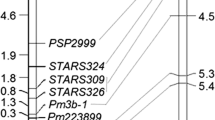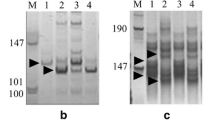Abstract
Powdery mildew, caused by Blumeria graminis f. sp. tritici, is one of the most important wheat diseases worldwide in areas with cool or maritime climates. Wild emmer (Triticum turgidum var. dicoccoides) is an important potential donor of disease resistances and other traits for common wheat improvement. A powdery mildew resistance gene was transferred from wild emmer accession G-303-1M to susceptible common wheat by crossing and backcrossing, resulting in inbred line P63 (Yanda1817/G-303-1 M//3*Jing411, BC2F6). Genetic analysis of an F2 population and the F2:3 families developed from a cross of P63 and a susceptible common wheat line Xuezao showed that the powdery mildew resistance in P63 was controlled by a single recessive gene. Molecular markers and bulked segregant analysis were used to characterize and map the powdery mildew resistance gene. Nine genomic SSR markers (Xbarc7, Xbarc55, Xgwm148, Xgwm257, Xwmc35, Xwmc154, Xwmc257, Xwmc382, Xwmc477), five AFLP-derived SCAR markers (XcauG3, XcauG6, XcauG10, XcauG20, XcauG22), three EST–STS markers (BQ160080, BQ160588, BF146221) and one RFLP-derived STS marker (Xcau516) were linked to the resistance gene, designated pm42, in P63. pm42 was physically mapped on chromosome 2BS bin 0.75–0.84 using Chinese Spring nullisomic-tetrasomic, ditelosomic and deletion lines, and was estimated to be more than 30 cM proximal to Xcau516, a RFLP-derived STS marker that co-segregated with the wild emmer-derived Pm26 which should be physically located in 2BS distal bin 0.84–1.00. pm42 was highly effective against 18 of 21 differential Chinese isolates of B. graminis f. sp. tritici. The closely linked molecular markers will enable the rapid transfer of pm42 to wheat breeding populations thus adding to their genetic diversity.


Similar content being viewed by others
References
Blanco A, Gadaleta A, Cenci A, Carluccio AV, Abdelbacki AMM, Simeone R (2008) Molecular mapping of the novel powdery mildew resistance gene Pm36 introgressed from Triticum turgidum var. dicoccoides in durum wheat. Theor Appl Genet 116:417–425
Chen XM, Luo YH, Xia XC, Xia LQ, Chen X, Ren ZL, He ZH, Jia JZ (2005) Chromosome location of powdery mildew resistance gene Pm16 in wheat using SSR marker analysis. Plant Breed 124:225–228
Delaney DE, Nasuda S, Endo TR, Gill BS, Hulbert SH (1995) Cytologically based physical maps of the group-2 chromosomes of wheat. Theor Appl Genet 91:568–573
Grama A, Gerechter-Amitai ZK (1974) Inheritance of resistance to stripe rust (Puccinia striiformis) in crosses between wild emmer (Triticum dicoccoides) and cultivated tetraploid and hexaploid wheats. II. Triticum aestivum. Euphytica 23:393–398
Hsam SLK, Huang XQ, Zeller FJ (2001) Chromosomal location of genes for resistance to powdery mildew in common wheat (Triticum aestivum L. em Thell.). 6. Alleles at the Pm5 locus. Theor Appl Genet 102:127–133
Huang XQ, Röder MS (2004) Molecular mapping of powdery mildew resistance genes in wheat: a review. Euphytica 137:203–223
Huang XQ, Wang LX, Xu MX, Röder MS (2003) Microsatellite mapping of the powdery mildew resistance gene Pm5e in common wheat (Triticum aestivum L.). Theor Appl Genet 106:858–865
Ji XL, Xie CJ, Ni ZF, Yang TM, Nevo E, Fahima T, Liu ZY, Sun QX (2007) Identification and genetic mapping of a powdery mildew resistance gene in wild emmer (Triticum dicoccoides) accession IW72 from Israel. Euphytica 159:385–390
Lebsock KL, Briggle LW (1974) Gene Pm5 for resistance to Erysiphe graminis f. sp. tritici in Hope wheat. Crop Sci 14:561–563
Liu ZY, Sun QX, Ni ZF, Nevo E, Yang TM (2002) Molecular characterization of a novel powdery mildew resistance gene Pm30 in wheat originating from wild emmer. Euphytica 123:21–29
McIntosh RA, Yamazaki Y, Dubcovsky J, Rogers J, Morris C, Somers DJ, Appels R, Devos KM (2008) Catalogue of gene symbols for wheat. In: Proceedings of the 11th International Wheat Genetic Symposium, University of Sydney Press, Australia
Mohler V, Zeller FJ, Wenzel G, Hsam SLK (2005) Chromosomal location of genes for resistance to powdery mildew in common wheat (Triticum aestivum L.em Thell.). 9. Gene MlZec1 from the Triticum dicoccoides-derived wheat line Zecoi-1. Euphytica 142:161–167
Moseman JG, Nevo E, El-Morshidy MA, Zohary D (1984) Resistance of Triticum dicoccoides collected in Isreal to infection with Erysiphe gramminis tritici. Euphytica 33:41–47
Moseman JG, Nevo E, Gerechter-Amitai ZK, El-Morshidy MA, Zohary D (1985) Resistance of Triticum dicoccoides collected in Israel to infection with Puccinia recondita tritici. Crop Sci 25:262–265
Negi MS, Devic M, Delseny M, Lakshmikumaran M (2000) Identification of AFLP fragments linked to seed coat colour in Brassica juncea and conversion to a SCAR marker for rapid selection. Theor Appl Genet 101:146–152
Nevo E, Gerechter-Amitai ZK, Beiles A (1991) Resistance of wild emmer wheat to stem rust: ecological, pathological and allozyme associations. Euphytica 53:121–130
Nevo E, Korol AB, Beiles A, Fahima T (2002) Evolution of wild emmer and wheat improvement. Population genetics, genetic resources, and genome organization of wheat progenitor, Triticum dicoccoides. Springer, Heidelberg
Reader SM, Miller TE (1991) The introduction into bread wheat of a major gene for resistance to powdery mildew from wild emmer wheat. Euphytica 53:57–60
Rong JK, Millet E, Manisterski J, Feldman M (2000) A new powdery mildew resistance gene: introgression from wild emmer into common wheat and RFLP-based mapping. Euphytica 115:121–126
Saghai-Maroof MA, Soliman KM, Jorgensen RA, Allard RW (1984) Ribosomal DNA spacer-length polymorphisms in barley: Mendelian inheritance, chromosomal locations and population dynamics. Proc Natl Acad Sci USA 81:8014–8018
Schneider DM, Heun M, Fischbeck G (1991) Inheritance of the powdery mildew resistance gene Pm9 in relation to Pm1 and Pm2 of wheat. Plant Breed 107:161–164
Singrün Ch, Hsam SLK, Zeller FJ, Wenzel G, Mohler V (2004) Localization of a novel recessive powdery mildew resistance gene from common wheat line RD30 in the terminal region of chromosome 7AL. Theor Appl Genet 109:210–214
Tao W, Liu D, Liu J, Feng Y, Chen P (2000) Genetic mapping of the powdery mildew resistance gene Pm6 in wheat by RFLP analysis. Theor Appl Genet 100:564–568
Xu H, Yao G, Xiong Li, Yang L, Jiang Y, Fu B, Zhao W, Zhang Z, Zhang C, Ma Z (2008) Identification and mapping of pm2026: a recessive powdery mildew resistance gene in an einkorn (Triticum monococcum L.) accession. Theor Appl Genet 117:471–477
Yahiaoui N, Srichumpa P, Dudler R, Keller B (2004) Genome analysis at different ploidy levels allows cloning of the powdery mildew resistance gene Pm3b from hexaploid wheat. Plant J 37:528–538
Yao GQ, Zhang JL, Yang LL, Xu HX, Jiang YM, Xiong L, Zhang CQ, Zhang ZZ, Ma ZQ, Sorrells ME (2007) Genetic mapping of two powdery mildew resistance genes in einkorn (Triticum monococcum L.) accessions. Theor Appl Genet 114:351–358
Zhu ZD, Zhou RH, Kong XY, Dong YC, Jia JZ (2005) Microsatellite markers linked to 2 powdery mildew resistance genes introgressed from Triticum carthlicum accession PS5 into common wheat. Genome 48:585–590
Acknowledgments
We are grateful to Dr. R. McIntosh for improving the manuscript. This work was financially supported by the National Fund for Distinguished Young Scholars (30425039), National Natural Science Foundation of China (30571151, 30771341), Beijing Natural Science Foundation (6061003), and the State High Tech Programs (2006AA100102, 2006AA10Z1E9, 2006AA10Z1C4, 2006AA10A104 and 2006BAD01A02), State Transgenic Project (2008ZX08009-002), the Program of Introducing Talents of Discipline to Universities (111-2-03), and the Program for Changjiang Scholars and Innovative Research Team in University. The gift of aneuploids and deletion stocks from Prof. B·S. Gill and Mr. W.J. Raupp, Wheat Genetic Resource Centre, Kansas State University, USA, and of RFLP probe WG516 by Drs. D. Benscher and M. Sorrells, Cornell University, NY, USA, are gratefully acknowledged.
Author information
Authors and Affiliations
Corresponding authors
Additional information
Communicated by B. Keller.
W. Hua, Z. Liu, and J. Zhu contributed equally to this work.
Electronic supplementary material
Below is the link to the electronic supplementary material.
Rights and permissions
About this article
Cite this article
Hua, W., Liu, Z., Zhu, J. et al. Identification and genetic mapping of pm42, a new recessive wheat powdery mildew resistance gene derived from wild emmer (Triticum turgidum var. dicoccoides). Theor Appl Genet 119, 223–230 (2009). https://doi.org/10.1007/s00122-009-1031-4
Received:
Accepted:
Published:
Issue Date:
DOI: https://doi.org/10.1007/s00122-009-1031-4




